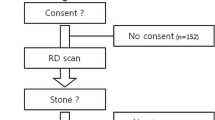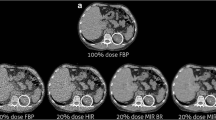Abstract
Purpose
To evaluate the efficacy of a knowledge-based iterative model reconstruction (IMR) algorithm for reducing image noise in ultralow-dose (ULD) CT for urolithiasis.
Materials and methods
A total of 103 patients diagnosed with urinary stones (n = 276) were enrolled. Regular dose (RD) scans (120 kV and 150 mAs, maximal tube current in dose modulation) were reconstructed using filtered back-projection (FBP, RD-FBP), and ULD scans (100 kV and 20 mAs, fixed tube current) were reconstructed with FBP (ULD-FBP), statistical iterative reconstruction (IR; ULD-iDose), and a knowledge-based IMR algorithm (ULD-IMR). Prospective interpretations of the two scans were performed with respect to radiation dose, objective image noise, and subjective assessment. The subjective assessment was also evaluated with regard to each patient’s body mass index (BMI, <25 or ≥25 kg/m2). Using RD CT (RD-FBP) as the reference standard, two reviewers assessed the diagnostic performance and inter-observer agreement for ULD-IMR.
Result
The average effective doses with RD CT and ULD CT were 8.31 and 0.68 mSv, respectively, and the average radiation dose reduction rate was 91.82% (p < 0.01). The lowest objective image noise was observed with ULD-IMR (p < 0.01). Subjective assessment in ULD-IMR was comparable to that of RD-FBP, although RD-FBP remained statistically superior. For BMI, there was a statistically significant difference in subjective image quality between the normal (4.7 ± 0.54) and overweight or obese groups (4.2 ± 0.5) (p < 0.05). The ULD-IMR showed a greater than 75% concordant rate in overall stones and 100% in ureter stones larger than 3 mm. However, for stones <3 mm, neither reviewer had a good detection rate (45.5% and 56.9% for the general and genitourinary radiologist, respectively). Inter-observer agreement was almost perfect (κ = 0.82).
Conclusion
Despite a significant radiation dose reduction, ULD-IMR images were comparable in image quality and noise to RD-FBP images. Furthermore, the diagnostic performance of the ULD non-enhanced CT protocol was comparable to that of the RD scan for diagnosing urinary stones larger than 3 mm.







Similar content being viewed by others
References
Youn JH, Kim SS, Yu JH, et al. (2012) Efficacy and safety of emergency ureteroscopic management of ureteral calculi. Korean J Urol 53:632–635
Preminger GM, Tiselius HG, Assimos DG, et al. (2007) 2007 guideline for the management of ureteral calculi. J Urol 178:2418–2434
Türk C, Knoll T, Petrik A, et al. Guidelines on Urolithiasis. In: EAU Guidelines, edition presented at the 25th EAU Annual Congress. Barcelona 2010
Huang WY, Chen YF, Chen SC, et al. (2012) Pediatric urolithiasis in Taiwan: a nationwide study, 1997–2006. Urology 79:1355–1359
VanDervoort K, Wiesen J, Frank R, et al. (2007) Urolithiasis in pediatric patients: a single center study of incidence, clinical presentation and outcome. J Urol 177:2300–2305
Scales CD Jr, Curtis LH, Norris RD, et al. (2007) Changing gender prevalence of stone disease. J Urol 177:979–982
Stamatelou KK, Francis ME, Jones CA, et al. (2003) Time trends in reported prevalence of kidney stones in the United States: 1976–1994. Kidney Int 63:1817–1823
Boulay I, Holtz P, Foley WD, et al. (1999) Ureteral calculi: diagnostic efficacy of helical CT and implications for treatment of patients. AJR Am J Roentgenol 172:1485–1490
Fulgham PF, Assimos DG, Pearle MS, Preminger GM (2013) Clinical effectiveness protocols for imaging in the management of ureteral calculous disease: AUA technology assessment. J Urol 189:1203–1213
Vieweg J, Teh C, Freed K, et al. (1998) Unenhanced helical computerized tomography for the evaluation of patients with acute flank pain. J Urol 160:679–684
Smith RC, Rosenfield AT, Choe KA, et al. (1995) Acute flank pain: comparison of non-contrast-enhanced CT and intravenous urography. Radiology 194:789–794
Pearce MS, Salotti JA, Little MP, et al. (2012) Radiation exposure from CT scans in childhood and subsequent risk of leukaemia and brain tumours: a retrospective cohort study. Lancet 380:499–505
Smith-Bindman R, Lipson J, Marcus R, et al. (2009) Radiation dose associated with common computed tomography examinations and the associated lifetime attributable risk of cancer. Arch Intern Med 169:2078–2086
Brenner DJ, Hall EJ (2007) Computed tomography—an increasing source of radiation exposure. N Engl J Med 357:2277–2284
Group L, Ahn S (2014) LOCAT (low-dose computed tomography for appendicitis trial) comparing clinical outcomes following low- vs standard-dose computed tomography as the first-line imaging test in adolescents and young adults with suspected acute appendicitis: study protocol for a randomized controlled trial. Trials 15:28
Ibrahim M, Parmar H, Christodoulou E, Mukherji S (2014) Raise the bar and lower the dose: current and future strategies for radiation dose reduction in head and neck imaging. AJNR Am J Neuroradiol 35:619–624
Love A, Olsson ML, Siemund R, et al. (2013) Six iterative reconstruction algorithms in brain CT: a phantom study on image quality at different radiation dose levels. Br J Radiol 86:20130388
Pickhardt PJ, Lubner MG, Kim DH, et al. (2012) Abdominal CT with model-based iterative reconstruction (MBIR): initial results of a prospective trial comparing ultralow-dose with standard-dose imaging. AJR Am J Roentgenol 199:1266–1274
Vardhanabhuti V, Ilyas S, Gutteridge C, et al. (2013) Comparison of image quality between filtered back-projection and the adaptive statistical and novel model-based iterative reconstruction techniques in abdominal CT for renal calculi. Insights Imaging 4:661–669
Botsikas D, Stefanelli S, Boudabbous S, et al. (2014) Model-based iterative reconstruction versus adaptive statistical iterative reconstruction in low-dose abdominal CT for urolithiasis. AJR Am J Roentgenol 203:336–340
Pooler BD, Lubner MG, Kim DH, et al. (2014) Prospective trial of the detection of urolithiasis on ultralow dose (Sub mSv) noncontrast computerized tomography: direct comparison against routine low dose reference standard. J Urol 192:1433–1439
Fleischmann D, Boas FE (2011) Computed tomography—old ideas and new technology. Eur Radiol 21:510–517
Shuman WP, Green DE, Busey JM, et al. (2013) Model-based iterative reconstruction versus adaptive statistical iterative reconstruction and filtered back projection in liver 64-MDCT: focal lesion detection, lesion conspicuity, and image noise. AJR Am J Roentgenol 200:1071–1076
Deak PD, Smal Y, Kalender WA (2010) Multidetector CT protocols: sex- and age-specific conversion factors used to determine effective dose from dose-length product. Radiology 257:158–166
Kulkarni NM, Uppot RN, Eisner BH, Sahani DV (2012) Radiation dose reduction at multidetector CT with adaptive statistical iterative reconstruction for evaluation of urolithiasis: how low can we go? Radiology 265:158–166
Neisius A, Wang AJ, Wang C, et al. (2013) Radiation exposure in urology: a genitourinary catalogue for diagnostic imaging. J Urol 190:2117–2123
Niemann T, Kollmann T, Bongartz G (2008) Diagnostic performance of low-dose CT for the detection of urolithiasis: a meta-analysis. AJR Am J Roentgenol 191:396–401
Mettler FA Jr, Huda W, Yoshizumi TT, Mahesh M (2008) Effective doses in radiology and diagnostic nuclear medicine: a catalog. Radiology 248:254–263
Ferrandino MN, Bagrodia A, Pierre SA, et al. (2009) Radiation exposure in the acute and short-term management of urolithiasis at 2 academic centers. J Urol 181:668–672 (discussion 673)
Fahmy NM, Elkoushy MA, Andonian S (2012) Effective radiation exposure in evaluation and follow-up of patients with urolithiasis. Urology 79:43–47
Thibault JB, Sauer KD, Bouman CA, Hsieh J (2007) A three-dimensional statistical approach to improved image quality for multislice helical CT. Med Phys 34:4526–4544
Yu Z, Thibault JB, Bouman CA, et al. (2011) Fast model-based X-ray CT reconstruction using spatially nonhomogeneous ICD optimization. IEEE Trans Image Process 20:161–175
Katsura M, Matsuda I, Akahane M, et al. (2012) Model-based iterative reconstruction technique for radiation dose reduction in chest CT: comparison with the adaptive statistical iterative reconstruction technique. Eur Radiol 22:1613–1623
Singh S, Kalra MK, Do S, et al. (2012) Comparison of hybrid and pure iterative reconstruction techniques with conventional filtered back projection: dose reduction potential in the abdomen. J Comput Assist Tomogr 36:347–353
Deak Z, Grimm JM, Treitl M, et al. (2013) Filtered back projection, adaptive statistical iterative reconstruction, and a model-based iterative reconstruction in abdominal CT: an experimental clinical study. Radiology 266:197–206
Marin D, Nelson RC, Schindera ST, et al. (2010) Low-tube-voltage, high-tube-current multidetector abdominal CT: improved image quality and decreased radiation dose with adaptive statistical iterative reconstruction algorithm—initial clinical experience. Radiology 254:145–153
Nelson RC, Feuerlein S, Boll DT (2011) New iterative reconstruction techniques for cardiovascular computed tomography: how do they work, and what are the advantages and disadvantages? J Cardiovasc Comput Tomogr 5:286–292
Mehta D, Thompson R, Morton T, Dhanantwari A, Shefer E (2013) Iterative model reconstruction: simultaneously lowered computed tomography radiation dose and improved image quality. Med Phys Int J 1:147–155
Khawaja RD, Singh S, Blake M, et al. (2015) Ultra-low dose abdominal MDCT: using a knowledge-based iterative model reconstruction technique for substantial dose reduction in a prospective clinical study. Eur J Radiol 84:2–10
Kwon JK, Chang IH, Moon YT, et al. (2015) Usefulness of low-dose nonenhanced computed tomography with iterative reconstruction for evaluation of urolithiasis: diagnostic performance and agreement between the urologist and the radiologist. Urology 85:531–538
Hur J, Park SB, Lee JB, et al. (2015) CT for evaluation of urolithiasis: image quality of ultralow-dose (Sub mSv) CT with knowledge-based iterative reconstruction and diagnostic performance of low-dose CT with statistical iterative reconstruction. Abdom Imaging . doi:10.1007/s00261-015-0411-2
Arac M, Celik H, Oner AY, et al. (2005) Distinguishing pelvic phleboliths from distal ureteral calculi: thin-slice CT findings. Eur Radiol 15:65–70
Boridy IC, Nikolaidis P, Kawashima A, et al. (1999) Ureterolithiasis: value of the tail sign in differentiating phleboliths from ureteral calculi at nonenhanced helical CT. Radiology 211:619–621
Jellison FC, Smith JC, Heldt JP, et al. (2009) Effect of low dose radiation computerized tomography protocols on distal ureteral calculus detection. J Urol 182:2762–2767
Acknowledgments
We appreciate the assistance of Philips Healthcare for providing the IMR prototype. We also appreciate the assistance in the working the study of Young Mi Chun (Philips Healthcare).
Author information
Authors and Affiliations
Corresponding author
Rights and permissions
About this article
Cite this article
Park, S.B., Kim, Y.S., Lee, J.B. et al. Knowledge-based iterative model reconstruction (IMR) algorithm in ultralow-dose CT for evaluation of urolithiasis: evaluation of radiation dose reduction, image quality, and diagnostic performance. Abdom Imaging 40, 3137–3146 (2015). https://doi.org/10.1007/s00261-015-0504-y
Published:
Issue Date:
DOI: https://doi.org/10.1007/s00261-015-0504-y




